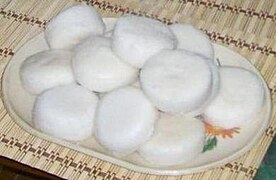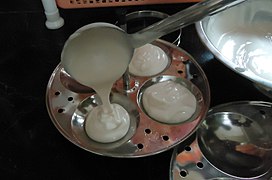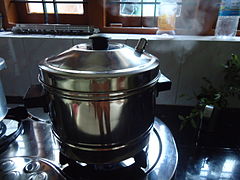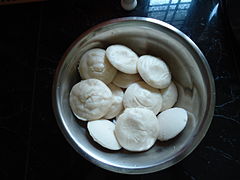Idli
Certain historical revisions of this page may meet criterion RD1 for revision deletion, as they contain significant copyright violations of http://bhavnaskitchen.com/rice-idlis/ (Copyvios report) that have been removed in the meantime.
Note to admins: In case of doubt, remove this template and post a message asking for review at WT:CP. With this script, go to the history with auto-selected revisions. Note to the requestor: Make sure the page has already been reverted to a non-infringing revision or that infringing text has been removed or replaced before submitting this request. This template is reserved for obvious cases only, for other cases refer to Wikipedia:Copyright problems. Note to others: Please do not remove this template until an administrator has reviewed it. |
Certain historical revisions of this page may meet criterion RD1 for revision deletion, as they contain significant copyright violations of http://www.tarladalal.com/glossary-instant-idli-mix-1287i (Copyvios report) that have been removed in the meantime.
Note to admins: In case of doubt, remove this template and post a message asking for review at WT:CP. With this script, go to the history with auto-selected revisions. Note to the requestor: Make sure the page has already been reverted to a non-infringing revision or that infringing text has been removed or replaced before submitting this request. This template is reserved for obvious cases only, for other cases refer to Wikipedia:Copyright problems. Note to others: Please do not remove this template until an administrator has reviewed it. |
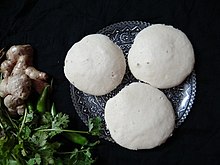 | |
| Alternative names | Idly |
|---|---|
| Course | Main course |
| Place of origin | India |
| Region or state | South India, Singapore, Sri Lanka and Malaysia |
| Serving temperature | Hot with a condiment such as sambar or chutney |
| Main ingredients | Black lentils (de-husked), rice |
| Variations | button idli, tatte idli, sanna, sambar idli, rava idli |
Idli Idli also romanized idly or iddly, plural idlis, is a traditional breakfast in south Indian households. Idli is savory cake of South India. Earliest mention of idli occurs in the Kannada writing called Vaddaradhane by Shivakotiacharya in 920 AD. A variant of Idli known as sanna is very popular amongst the Goans and other Konkani people. Another variant known as "Enduri Pitha" is very popular in Odisha. For preparation of "Enduri Pitha", mixture of black gram paste and ground once-boiled rice is wrapped in turmeric leaf and steam cooked.(/ɪdliː/) are a type of savoury rice cake, popular as breakfast foods throughout India and neighbouring countries like Sri Lanka. The cakes are made by steaming a batter consisting of fermented black lentils (de-husked) and rice.
Idli have several variations, including rava idli, which are made from semolina. Regional variants include sanna of Konkan and Enduri Pitha of Odisha.
History
A precursor of the modern idli is mentioned in several ancient Indian works. Vaddaradhane, a 920 CE Kannada language work by Shivakotiacharya mentions "iddalige", prepared only from a black gram (urad dal) batter. Chavundaraya II, the author of the earliest available Kannada encyclopaedia, Lokopakara (c. 1025 CE), describes the preparation of this food by soaking black gram in buttermilk, ground to a fine paste, and mixed with the clear water of curd and spices.[1] The Western Chalukya king and scholar Someshwara III, reigning in the area now called Karnataka, included an idli recipe in his encyclopedia, Manasollasa (1130 CE). This Sanskrit-language work describes the food as iḍḍarikā.[2] The food prepared using this recipe is now called uddina idli in Karnataka.
The recipe mentioned in these ancient Indian works leaves out three key aspects of the modern idli recipe: the use of rice (not just urad dal), the long fermentation of the mix, and the steaming for fluffiness. The references to the modern recipe appear in the Indian works only after 1250 CE. Food historian K. T. Achaya speculates that the modern idli recipe might have originated in present-day Indonesia, which has a long tradition of fermented food. According to him, the cooks employed by the Hindu kings of the Indianised kingdoms might have invented the steamed idli there, and brought the recipe back to India during 800-1200 CE.[3][4] Achaya mentioned an Indonesian dish called "kedli", which according to him, was like an idli.[5][3] However, Janaki Lenin was unable to find any recipe for an Indonesian dish by this name.[6]
The Gujarati work Varanaka Samuchaya (1520 CE) mentions idli as idari, and also mentions its local adaption idada (a non-fermented version of dhokla).[7] The earliest extant Tamil work to mention idli (as itali) is Maccapuranam, dated to the 17th century.[8][9]
Preparation
| Nutritional value per 1 piece (30 gm) | |||||||||||||
|---|---|---|---|---|---|---|---|---|---|---|---|---|---|
| Energy | 167 kJ (40 kcal) | ||||||||||||
7.89 g | |||||||||||||
| Dietary fiber | 1.5 g | ||||||||||||
0.19 g | |||||||||||||
| Saturated | 0.037 g | ||||||||||||
| Monounsaturated | 0.035 g | ||||||||||||
| Polyunsaturated | 0.043 g | ||||||||||||
1.91 g | |||||||||||||
| |||||||||||||
| †Percentages estimated using US recommendations for adults,[11] except for potassium, which is estimated based on expert recommendation from the National Academies.[12] Source: [10] | |||||||||||||


Variations
In addition to or instead of fenugreek other spices may be used such as mustard seeds, chili peppers, cumin, coriander, ginger, etc.[13] Sugar may be added to make them sweet instead of savory. Idli may also be stuffed with a filling of potato, beans, carrot and masala.[14] Leftover idlis can be cut-up or crushed and sautéed for a dish called idli upma.[15] You can even prepare dahi idli by combining curd and idli together and then tempering the dish.
-
Idli and vada served with sambar and two types of chutneys (green and red) on banana leaf or plate
-
Tatte idli, a plate sized variant of Idli from Karnataka
-
Mini Sambar Idli, mini idlis floating in sambar as served in Tamil Nadu
-
Muday idli is a Mangalorean variant of idli.
Gallery
- Idli Making
-
Idli batter
-
Idli thattu
-
Batter poured into thattu
-
Stack the thattu one over another
-
Steam the idli until the steam comes out from cooker
-
Idli at cooker
-
Detach the making pan
-
Idlis detached
See also
References
- ^ Farnworth (2003), p. 11.
- ^ K. T. Achaya (1994), p. 90.
- ^ a b K.T. Achaya (1 November 2003). The Story of Our Food. Universities Press. pp. 80–. ISBN 978-81-7371-293-7.
- ^ D. Balasubramanian (2004-10-21). "Changes in the Indian menu over the ages". The Hindu.
- ^ Idli saga: A study into the origin of the South Indian dish
- ^ A tale of two sambhars
- ^ Achyut Yagnik; Suchitra Seth (24 August 2005). Shaping Of Modern Gujarat. Penguin Books Limited. p. 24. ISBN 978-81-8475-185-7.
- ^ Vikram Doctor (2007-04-28). "Idli saga: A study into the origin of the South Indian dish". Economic Times. Retrieved 2014-08-25.
- ^ K.T. Achaya (5 March 2009). The Illustrated Foods of India. OUP India. ISBN 978-0-19-569844-2.
- ^ http://www.fatsecret.co.in/calories-nutrition/generic/idli
- ^ United States Food and Drug Administration (2024). "Daily Value on the Nutrition and Supplement Facts Labels". FDA. Archived from the original on 2024-03-27. Retrieved 2024-03-28.
- ^ National Academies of Sciences, Engineering, and Medicine; Health and Medicine Division; Food and Nutrition Board; Committee to Review the Dietary Reference Intakes for Sodium and Potassium (2019). Oria, Maria; Harrison, Meghan; Stallings, Virginia A. (eds.). Dietary Reference Intakes for Sodium and Potassium. The National Academies Collection: Reports funded by National Institutes of Health. Washington, DC: National Academies Press (US). ISBN 978-0-309-48834-1. PMID 30844154. Archived from the original on 2024-05-09. Retrieved 2024-06-21.
- ^ Rachana, Gorikapudi (2012). "Fenugreek Leaves Idli". SPICY CURRIES. Retrieved 14 October 2014.
- ^ "Stuffed Idli". Spicy Tasty. 2013. Retrieved 14 October 2014.
- ^ "Idli Upma Recipe-Recipe with Leftover idlis". Padhu's Kitchen. 2012. Retrieved 14 October 2014.
Bibliography
- K. T. Achaya (May 12, 1994). Indian Food: A Historical Companion. Oxford University Press, USA. ISBN 978-0-19-563448-8.
- Devi, Yamuna (1987). Lord Krishna's Cuisine: The Art of Indian Vegetarian Cooking, Dutton. ISBN 0-525-24564-2.
- Farnworth, Edward R. (2003). Handbook of Fermented Functional Foods. CRC Press. ISBN 978-0-8493-1372-1.
- Jaffrey, Madhur (1988). A Taste of India, Atheneum. ISBN 0-689-70726-6.
- Rau, Santha Rama (1969). The Cooking of India, Time-Life Books.




